TechEdSat-5
Non-EO
NASA
Mission complete
ARC
Quick facts
Overview
| Mission type | Non-EO |
| Agency | NASA, ARC |
| Mission status | Mission complete |
| Launch date | 09 Dec 2016 |
| End of life date | 29 Jul 2017 |
TechEdSat-5 (Technical Education Satellite-5)
Launch Exo-Brake Mission Status References
The TechEdSat-5 nanosatellite is a 3U CubeSat, also referred to as TES-5, developed by students of SJSU (San Jose State University), the University of Idaho and NASA/ARC (Ames Reserach Center).
TES-5 Science/Mission Objectives 1)
• Establish improved uncertainty analysis for eventual controlled flight through the thermosphere (perform detailed comparison to the TES-3 and TES-4 with respect to key thermosphere variable uncertainty).
• Improve prediction of re-entry location.
• Provide the base technology for sample return technology from orbital platforms.
• Provide the eventual testing of independent TDRV-based planetary missions.
• Provide engineering data for an On-Orbit Tracking Device that could improve the prediction of jettisoned material from the ISS (per discussions with the TOPO group).
Tracking System | TES-1 | TES-2 | TES-3p | TES-4 | SOARE X-8 | SOARE X-9 | TES-5 |
Iridium | N/A | 1616-1626.5 MHz | 1616-1626.5 MHz | 1616-1616.5 MHz | 1616-1626.5 MHz | 1616-1626.5 MHz | 1616-1626.5 MHz |
StenSat | 437.465 MHz | N/A | 437.465 MHz | N/A | N/A | N/A | N/A |
ISM | N/A | N/A | N/A | N/A | 2457 MHz | 2457 MHz | 2457 MHz |
WSM | N/A | N/A | N/A | N/A | 2410 MHz | 2410 MHz | 2410 MHz |
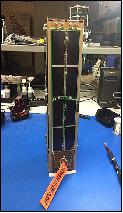
Technologies that will be Demonstrated on TechEdSat-5 (Ref.10)
• The ‘Cricket' Wireless Sensor Module (WSM), which provides a unique wireless network for multiple wireless sensors, providing real time data for TechEdSat-5.
• TechEdSat-5's nanosatellite bus element will also utilize the PhoneSat-5 avionics board that uses, for the first time, the versatile Intel Edison microprocessor. The new board is designed to test TechEdSat-5's unique Wi-Fi capabilities, high fidelity cameras, and contains Iridium L-band transceiver for data.
In addition to the goal of returning samples from the space station, the project seeks to develop "building blocks" for larger scale systems that might enable future small or nanosatellite missions to reach the surface of Mars and other planetary bodies in the solar system.
The SPQR (Small Payload Quick Return) project provides the capability of returning small payloads in a temperature and pressure controlled environment - from the ISS (International Space Station). The current 3U CubeSat experiment of TechEdSat-5 is the next development step in the series. The principal objectives are to further develop the tension-based drag device (an 'Exo-Brake') and demonstrate frequent uplink/downlink control capability. In addition, the Exo-Brake is modulated in order to change the drag profile – and then permit, for the first time, a targeting experiment. The current experiment is sized at a scale of 0 .3 m, which would permit reentry within 4 weeks (at ~ 5 kg/m2). Understanding the thermophysics of such a device would eventually permit it to be scaled for larger payloads and reentry within 1.5 days. Secondary objectives include the further development of the avionics suite. This eventually includes redundant GPS - Iridium modules which periodically update positional/altitude information which assist in the eventual guidance/targeting of the larger SPQR units. As with the precursors TechEdSat-1, TechEdSat-3P, TechEdSat-4, TechEdSat-5 is designed from the onset with important safety features, including two-fault tolerant critical safety attributes, in particular, use of redundant ALI ( Auxiliary Lateral Inhibit) switches, which prevent early electrical/RF activation -as well as inhibits for any jettison anomalies. 2)

Launch
The TechEdSat-5 nanosatellite was part of the CubeSat payload cargo on the HTV-6 (H-II Transfer Vehicle-6 / Kounotori-6) mission of JAXA, launched to the ISS on December 9, 2016 from TNSC (Tanegashima Space Center), Japan. 3)
Orbit
Near circular orbit of the ISS, altitude of ~ 400 km, inclination = 51.6º.
HTV-6/Kounotori-6 started its final approach to the ISS (International Space Station), and was captured by the ISS robotic arm at 10:39 UTC on December 13. Being captured and maneuvered by the robotic arm, the HTV-6 was successfully berthed to the ISS at 18:24 UTC. 4) 5)
The following CubeSats were part of the HTV-6 cargo. They will be deployed from Kibo using the upgraded J-SSOD-2(JEM Small Satellite Orbital Deployer-2), featuring a doubled deployment capacity. 6)
• AOBA-Velox-III, a 2U CubeSat of Kyutech (Kyushu Institute of Technology), Japan and NTU (Nanyang Technological University), Singapore. The objective is to demonstrate the performance of a PPT (Pulsed Plasma Thruster).
• TuPOD (Satellite/deployer containing first TubeSats), a 3U CubeSat of JAMSS/GAUSS Srl (Italy)/Tancredo elementary school & INPE (Brazil) / OSN (Open Space Network, USA). Objective: Deployment of two 1.5U CubeSats (called TubeSats). 7)
Note: JAMSS (Japan Manned Space Systems Corporation), Tsukuba, operation and utilization support of JEM.
• EGG (re-Entry satellite with Gossamer aeroshell and GPS/Iridium), a 3U CubeSat of the University of Tokyo, Japan. Objective: Inflation of a torus-shaped aeroshell and its deorbit demonstration.
• ITF-2 (Imagine The Future-2), a 1U CubeSat of the University of Tsukuba, Japan. Objective: Building a ground network using amateur radio via a satellite.
• UBSKUSAT, a 3U CubeSat, a joint Turkish and Japanese venture of ITU (Istanbul Technical University) Turkey, and Kyutech (Kyushu Institute of Technology), Japan.
• STARS-C, a 2U CubeSat of Shizuoka University, Japan. Objective: Technology demonstration of tether extension between two 1U CubeSats.
• FREEDOM, a 1U CubeSat of Nakashimada Engineering Works, Ltd./Tohoku University, Japan. Objective: Deployment of a film-type deorbiting device.
• WASEDA-SAT3, a 1U CubeSat of Waseda University, Japan. Objective: Deployment of a film-type deorbiting device and image protection onto the film surface using a micro-miniature projector.
• TechEdSat-5, a 3U CubeSat, developed by students of SJSU (San Jose State University), the University of Idaho, and NASA/ARC (Ames Reserach Center).
• Lemur-2, four 3U CubeSats of Spire Global to provide AIS (Automatic Identification System) tracking services.
Mission Status
• TechEdSat-5 – a drag brake CubeSat – reentered the atmosphere on July 29, 2017 after 144 days in orbit – indicating the craft's drag brake provided a significant acceleration of orbital decay as non-propulsive satellites deployed from ISS typically last close to one year in orbit. 8)
• March 7, 2017: After a two-month stay aboard the International Space Station, NASA's TechEdSat-5) that launched Dec. 9, 2016, was deployed on March 6, 2017 from the NanoRacks platform and into low-Earth orbit to demonstrate a critical technology that may allow safe return of science payloads to Earth from space. 9)
- Orbiting about 400 km above Earth, the Exo-Brake, a tension-based, flexible braking device resembling a cross-shaped parachute, opens from the rear of the small satellite to increase the drag. This de-orbit device tests a hybrid system of mechanical struts and flexible cord with a control system that warps the Exo-Brake. This allows engineers to guide the spacecraft to a desired entry point without the use of fuel, enabling accurate landing for future payload return missions.
- Two additional technologies will be demonstrated on TechEdSat-5. These include the ‘Cricket' Wireless Sensor Module, which provides a unique wireless network for multiple wireless sensors, providing realtime data for TechEdSat-5.

Exo-Brake
NASA's "Exo-Brake" will demonstrate a critical technology leading to the potential return of science payloads to Earth from the International Space Station through the deployment of small spacecraft in early 2017. 10)
An Exo-Brake is a tension-based, flexible braking device resembling a cross-parachute that deploys from the rear of a satellite to increase the drag. It is a de-orbit device that replaces the more complicated rocket-based systems that would normally be employed during the de-orbit phase of reentry.
"The Exo-Brake's current design uses a hybrid system of mechanical struts and flexible cord with a control system that 'warps' the Exo-Brake - much like how the Wright brothers used warping to control the flight behavior of their first wing design," said Marcus Murbach, principal investigator and inventor of the Exobrake device.
This warping, combined with real-time simulations of the orbital trajectory, allows engineers to guide the spacecraft to a desired entry point without the use of fuel, enabling accurate landing for future payload return missions.
Engineers at NASA/ARC (Ames Research Center) in California's Silicon Valley, have been testing the Exo-Brake technology as a simple design that promises to help bring small payloads back through Earth's atmosphere unharmed. The technology demonstration mission is a part of the TechEdSat-5 nanosatellite that was launched Dec. 9 on Japan's HTV-6 (H-II Transfer Vehicle-6) from Tanegashima Space Center in Japan. The Exo-Brake will reside on the space station until its deployment in early 2017.
Since 2012, the Exo-Brake has been tested on balloons and sub-orbital rockets through the SOAREX ( Sub-Orbital Aerodynamic Reentry Experiments) flight series. Earlier versions of the Exo-Brake and other critical systems also have been tested on orbital experiments on TechEdSat nanosatellite missions.
The Exo-Brake is funded by the Entry Systems Modeling project within the Space Technology Mission Directorate's Game Changing Development program. Additional funding for the Exo-Brake is provided by NASA/ARC ( Ames Research Center) and the NASA Engineering and Safety Center. The TechEdSat series of nanosatellites is a STEM collaborative activity that involves NASA early-career employees, interns and students from several universities including San Jose State University, University of Idaho, University of California at Riverside, and California Polytechnic San Luis Obispo.
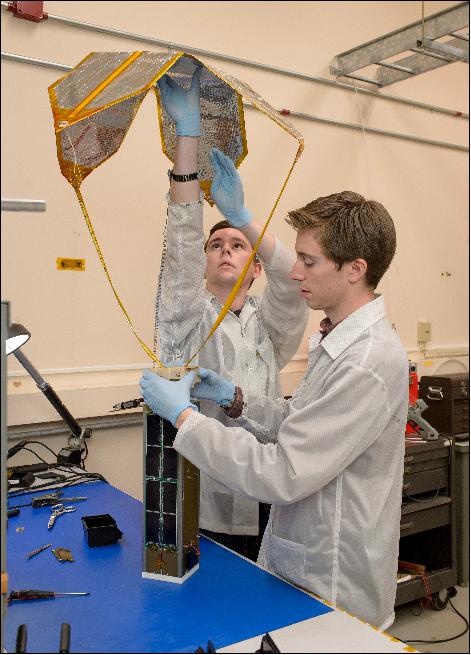
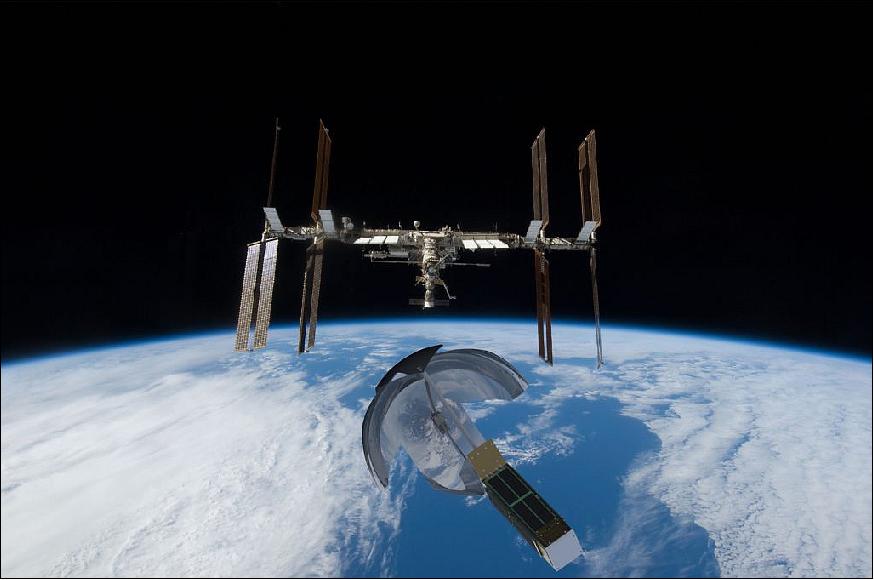
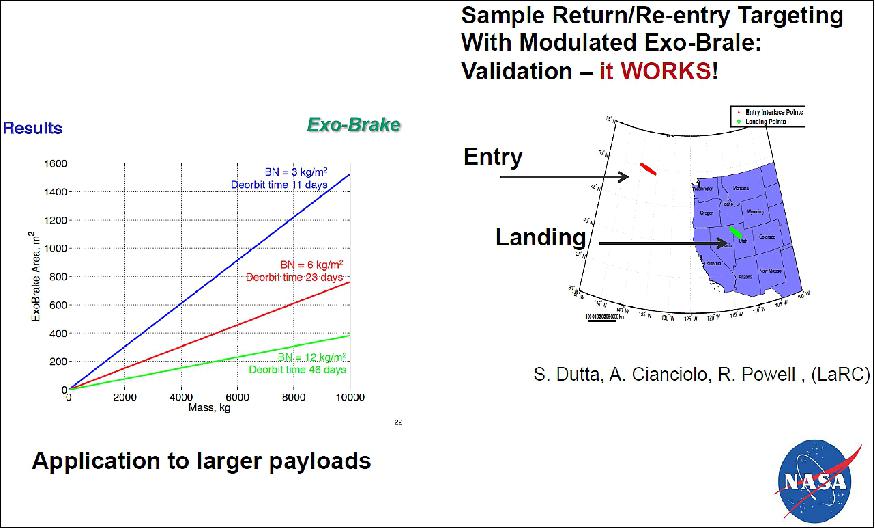
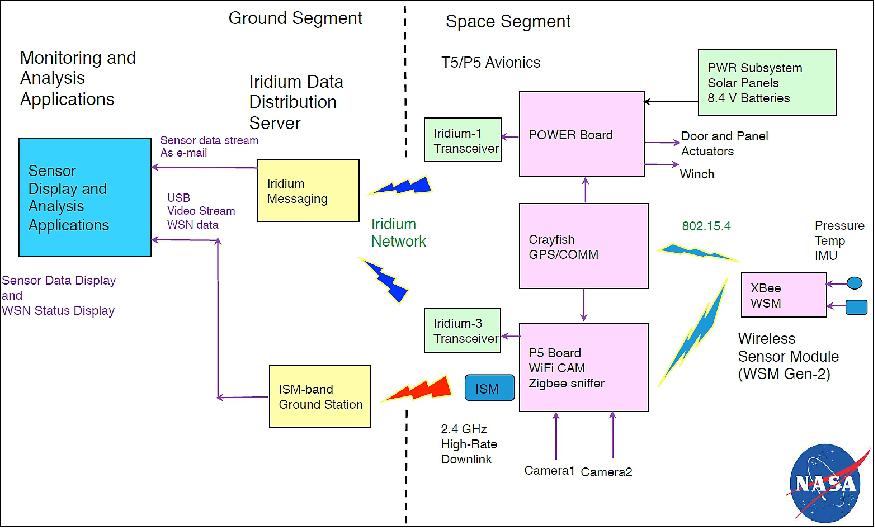
References
1) M.Murbach, R. Alena, A. Guarneros Luna C. Priscal, R. Shimmin J. Wheless, F. Tanner, R. Morrison, K. Oyadomari P. Papadopoulos/SJSU, D. Atkinson/UofIdaho, TES/PSAT-Team"TechEdSat 5 / PhoneSat 5 (T5/P5), SmallSat Presentation 2016," Proceedings of the 30th Annual AIAA/USU SmallSat Conference, Logan UT, USA, August 6-11, 2016, paper: SSC16-VII-6, URL: http://digitalcommons.usu.edu/cgi/viewcontent.cgi?article=3490&context=smallsat
2) "Development of On-Demand Sample Return Capability–Small Payload Quick Return (TechEdSat-5)," NASA News, Nov. 22, 2016, URL: https://www.nasa.gov/mission_pages/station/research/experiments/2359.html
3) "Launch success of the H-IIB Launch Vehicle No. 6 (H-IIB F6) with the H-II Transfer Vehicle "KOUNOTORI6" on board," JAXA Press Release, December 10, 2016, URL: http://global.jaxa.jp/press/2016/12/20161210_h2bf6.html
4) "Successful berthing of the H-II Transfer Vehicle "KOUNOTORI6" (HTV6) to the International Space Station (ISS)," JAXA, December 14, 2016, URL: http://global.jaxa.jp/press/2016/12/20161214_kounotori6.html
5) "Japan's H-II Transfer Vehicle Successfully Berthed to Space Station for Resupply Mission with Historic Payloads from NanoRacks Customers," NanoRacks, Dec. 13, 2016, URL: http://nanoracks.com/wp-content/uploads/NanoRacks-Release-58-H-II-Transfer-Vehicle-Successfully-Berthed-1.pdf
6) "CubeSat deployment from Kibo — J-SSOD#5/#6 CubeSat deployment mission," URL: http://iss.jaxa.jp/en/htv/mission/htv-6/images/jssod_5_6_mission.pdf
7) "TuPOD Handover to JAXA Accomplished," GAUSS Srl, Nov. 8, 2016, URL: https://www.gaussteam.com/tupod-handover-to-jaxa-accomplished/
8) "Re-Entry: TechEdSat-5 ," Spaceflight 101, July 29, 2017, URL: http://spaceflight101.com/re-entry/re-entry-techedsat-5/
9) "NASA Parachute Device Could Return Small Spacecraft from Deep Space Missions," NASA, March 7, 2017, URL: https://www.nasa.gov/ames/image-feature/nasa-parachute
device-may-return-small-spacecraft-from-deep-space-missions
10) Kimberly Williams, "NASA's Exo-Brake 'Parachute' to Enable Safe Return for Small Spacecraft," NASA Space Technology, Dec. 13, 2016, URL: https://gameon.nasa.gov/2016/12/13/nasas-exo-brake
parachute-to-enable-safe-return-for-small-spacecraft/
The information compiled and edited in this article was provided by Herbert J. Kramer from his documentation of: "Observation of the Earth and Its Environment: Survey of Missions and Sensors" (Springer Verlag) as well as many other sources after the publication of the 4th edition in 2002. - Comments and corrections to this article are always welcome for further updates (eoportal@symbios.space).